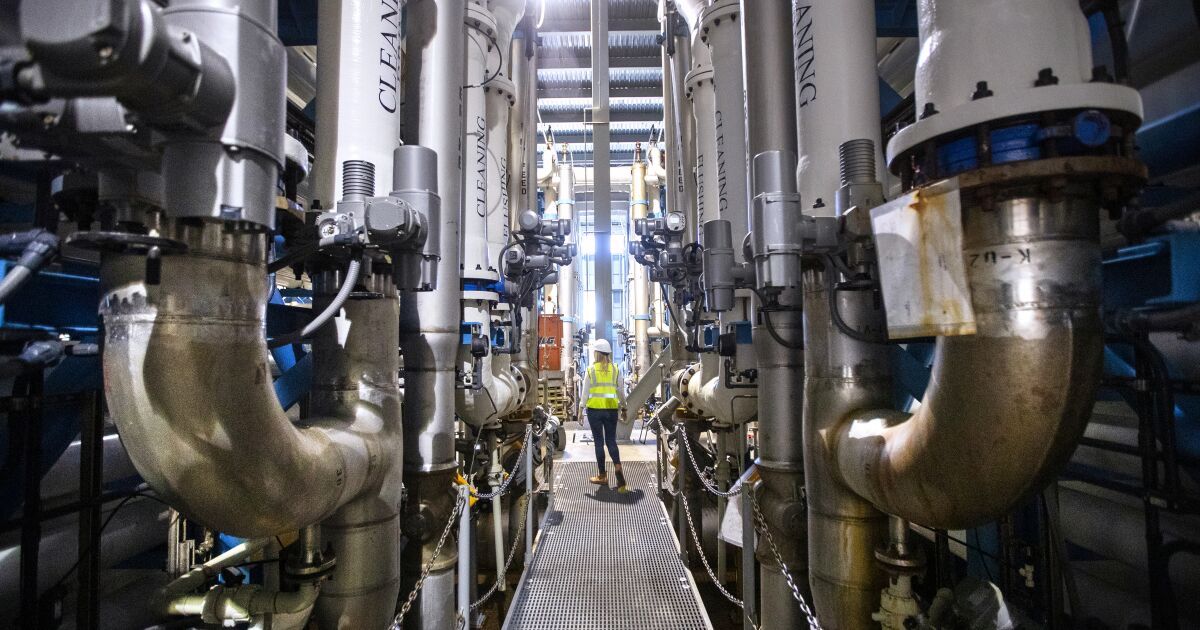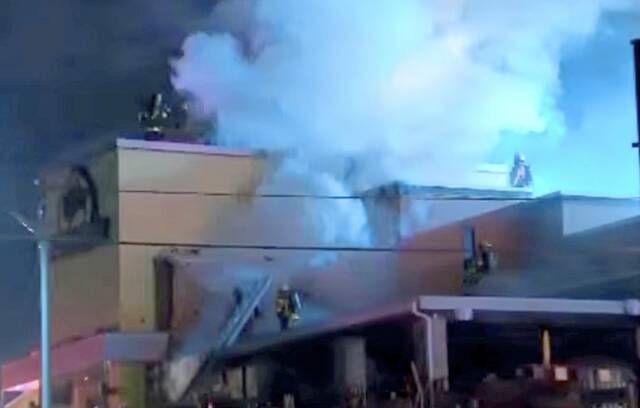Newsom unveils plan to speed up infrastructure in California
A worker walks through the Claude “Bud” Lewis Desalination Plant in Carlsbad. Gov. Gavin Newsom released a plan Friday that would make it easier to build water, clean energy and transportation projects as well as other infrastructure in Cailifornia.
Surrounded by hard hat-wearing construction workers at a solar and energy storage project in the Central Valley, Gov. Gavin Newsom unveiled a sweeping package of legislation and signed an executive order Friday to make it easier to build transportation, clean energy, water and other infrastructure across California. The governor said the proposal intends to cut through bureaucratic hurdles that have stymied grand public works projects and will help California capitalize on an infusion of money from the Biden administration to boost climate-friendly construction.
Newsom’s proposal aims to shorten the contracting process for bridge and water projects, limit timelines for environmental litigation and simplify permitting for complicated developments in the Sacramento-San Joaquin River Delta and elsewhere.
Altogether, administration officials hope the package could speed up project construction by more than three years and reduce costs by hundreds of millions of dollars — efforts they say are necessary to achieve the state’s aggressive climate goals.
Advertisement
Newsom characterized the proposal as essential to restoring trust that government can improve people’s lives, especially under the threat of climate change.
“That urgency is around actually delivering on what we promote and promise,” Newsom said.
The plan consists of 11 bills, and Newsom said he wants to fold the package into the 2023-24 state budget, which must pass both houses of the Legislature by June 15. Lawmakers are currently negotiating the final details of the fiscal blueprint with Newsom’s office.
At the center of Newsom’s plan is the California Environmental Quality Act — a polarizing 1970 law credited for helping preserve the state’s natural beauty but often criticized for miring needed housing, energy and transportation projects in litigation.
The proposal does not make major changes to the law, which requires public officials, agencies and developers to broadly consider and make public a project’s effects on the existing environment. Rather, it attempts to limit how long environmental lawsuits can drag out in court.
The proposal aims to prevent any lawsuit against certain water, transportation, clean energy, semiconductor and microelectronics projects from lasting longer than nine months.
Qualifying projects, administration officials said, would include the governor’s $16-billion plan to build a tunnel to transport water to Southern California beneath the Sacramento-San Joaquin River Delta, water recycling and desalination plants, solar fields, offshore wind farms and energy transmission.
The idea is similar to procedures already in place that have helped expedite the construction of NBA arenas in San Francisco and Sacramento as well as other megadevelopments across the state.
“I love sports,” Newsom said. “But I also love roads. I love transit. I love bridges. And I love clean energy projects like the one we’re seeing here. It’s not just about stadiums. And we’ve proven we can get it done for stadiums. So why the hell can’t we translate that to all these other projects?”
Additional CEQA changes in the plan would give government agencies greater control over deciding what’s needed in a project’s official administrative record and overturn a recent appellate court decision that required the inclusion of internal emails as part of that record. Litigation on the email issue involving a large residential and commercial development proposal in San Diego County lasted nearly two years after it was approved.
Debates over quickening the state’s sluggish process for building major infrastructure have been happening for decades. Major reforms have often failed in the thicket of environmental, development, local government and labor interests that are influential at the Capitol. Newsom said Thursday that his administration has led an organized effort to bring interest groups on board.
Gayle Miller, chief deputy director of policy at the state Department of Finance, told The Times that the plan offered a “reasonable approach” to addressing California’s complex environmental law.
“We’re not trying to destroy our environmental protections in California. But we’re certainly trying to say enough is enough,” Miller said. “We need to move forward and transition the state to its clean energy future.”
Newsom said it was essential to make changes now because of the $180 billion in state and federal funds expected to be available for infrastructure in California over the next decade, an amount boosted by allocations from President Biden’s signature infrastructure and climate change laws.
The governor likened that investment to those made in the state during its historic period of infrastructure investments in the 1950s and ’60s.
“The question is, are we going to screw it up by being consumed by paralysis and process?” Newsom said. “We’re here to assert a different paradigm, to commit ourselves to results.”
To kick-start this process, Newsom also signed an executive order Friday that will instruct various government agencies to work together and create an infrastructure strike team, which in theory will target projects that need to be completed and make sure they get across the finish line.
The newly available federal dollars also include many clean energy and other competitive grants. For California to win, it needs to show the federal government that it can deliver, the governor said.
Newsom, a Democrat, said those investments are in jeopardy if discussions in Washington over whether to raise the debt limit sour.
GOP House Speaker Kevin McCarthy (R-Bakersfield) said Republicans would only agree to raise the limit if Biden agreed to roll back certain provisions of the Inflation Reduction Act, which includes ambitious climate plans and funding for infrastructure projects.
“If Kevin McCarthy has his way, that’s going to set us back,” Newsom said at an event in Sacramento previewing his plan Thursday. “What he’s promoting would have devastating impact on our progress.”
Other elements of Newsom’s package would ease contracting barriers that state agencies run into when starting and finishing their projects.
Newsom wants to allow the state Department of Water Resources and the California Department of Transportation to use a more flexible contracting process for up to eight complex projects each, which could streamline construction and reduce logistical snafus that cause delays. Another proposal would allow the transportation department to use a simpler job contracting model that could cut months off of a project’s timeline.
The departments could use these streamlining tactics to more quickly build bridges or modernize dams, repair aqueducts or maintain the state highway system. The package would also expedite three planned wildlife crossings along Interstate 15 in San Bernardino County.
The final part of Newsom’s plan would streamline Caltrans’ environmental mitigation efforts and permitting for projects that affect endangered species or are within the Sacramento-San Joaquin River Delta.
Source: Los Angeles Times


